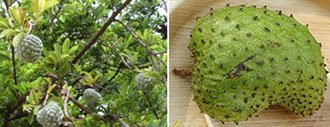Annona is a small-sized tree, grows to about 15 to 30 feet tall with dense foliage, and bears fruits after 4-5 years of plantation. In their natural habitat, cherimoya flowers are pollinated by insects (Coleoptera, Hemiptera). However, in the cultivated farms, artificial pollination is done at large to obtain good yields.
 |
| Custard apple and Soursop (Guanabana). |
The fruit is irregularly oval or conical in shape featuring leathery dark-green skin with polygonal indentations. It measures about 10-15 cm in length and 10 cm in diameter and weighs about 350 g to 500 g. In some varieties, they weigh several pounds.
Ripe fruits turn pale green to light brown and emanate a sweet, fragrant aroma that can be appreciated from a distance. Inside the flesh is creamy with several smooth, shiny, black seeds embedded in it. Seeds and skin are inedible.
Custard apple (Annona reticulata) is another closely related fruit commonly grown in India, Pakistan, and other South Asian regions. It features smooth, conical indentations.
Sugar apple or atis fruit (A. squamosa) features smooth conical protuberances (carpels) over its surface. It has a similar taste and flavor as cherimoya; however, on its interior, it contains relatively less flesh but more seeds for its size.
Atemoya is hybrid of cherimoya (A. cherimola) and sugar apple (A. squamosa). It has better temperature and humidity tolerance, suitable for cultivation in tropical climates.
Guanabana (Annona muricata), also known as soursop (graviola), is much larger than cherimoya. It is easily distinguished by its size, spiky surface, and fibrous, tart flesh.

